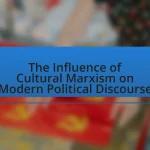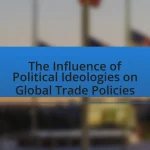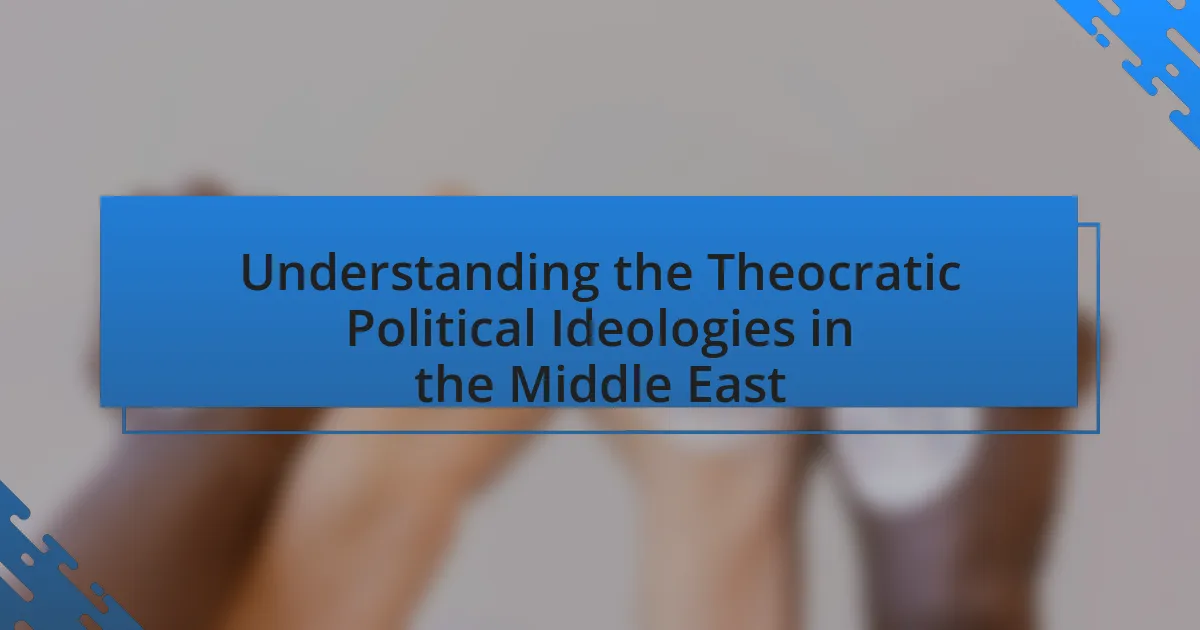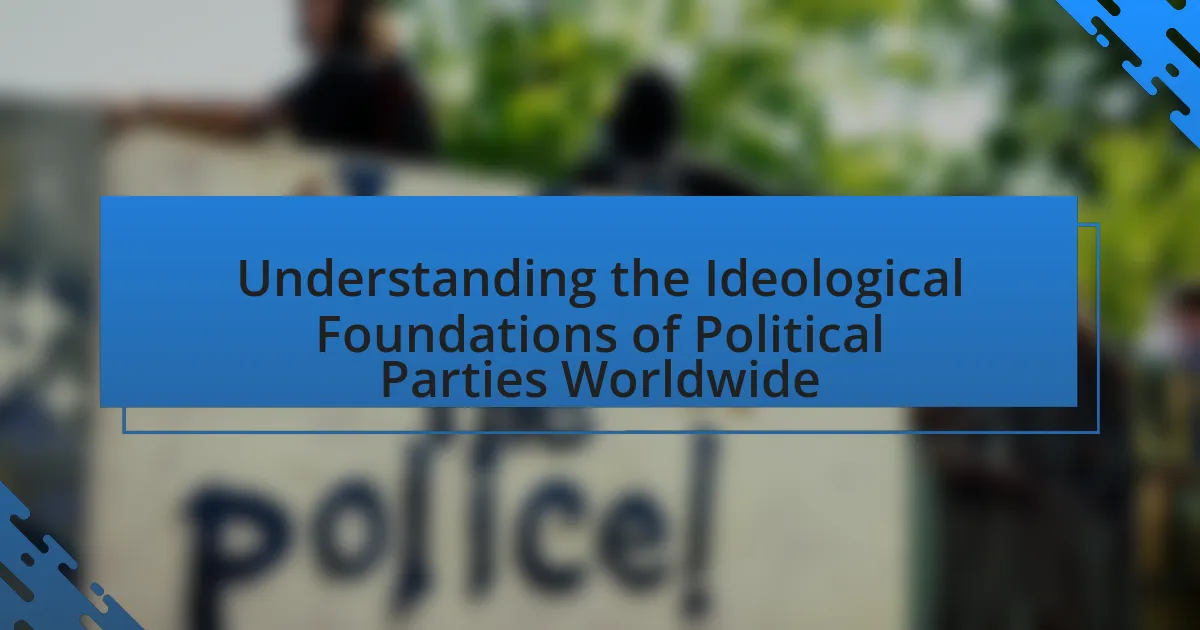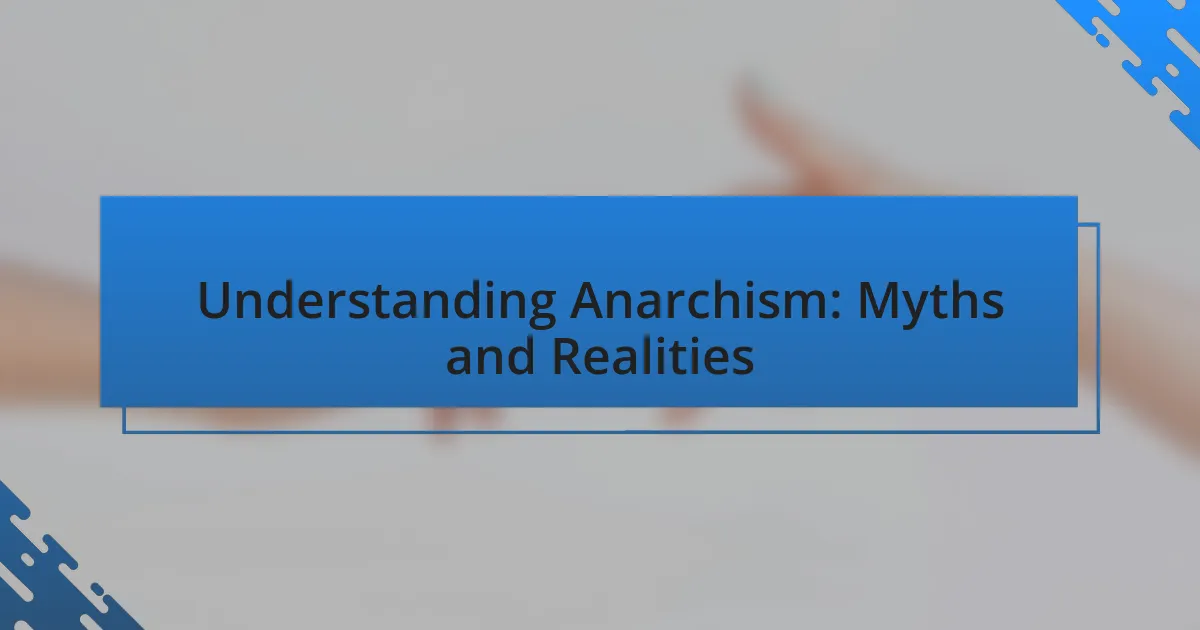The article examines the intersection of religion and politics, highlighting how religious beliefs and institutions influence political structures, policies, and behaviors. It explores the reciprocal relationship between religion and politics, illustrated through historical examples such as the Catholic Church’s role in medieval Europe and the impact of evangelical movements in contemporary America. The article also discusses cultural perceptions of this relationship, the importance of studying it for understanding governance and societal norms, and the implications for human rights and freedoms. Additionally, it addresses contemporary issues, challenges, and best practices for navigating the complex dynamics between faith and governance.
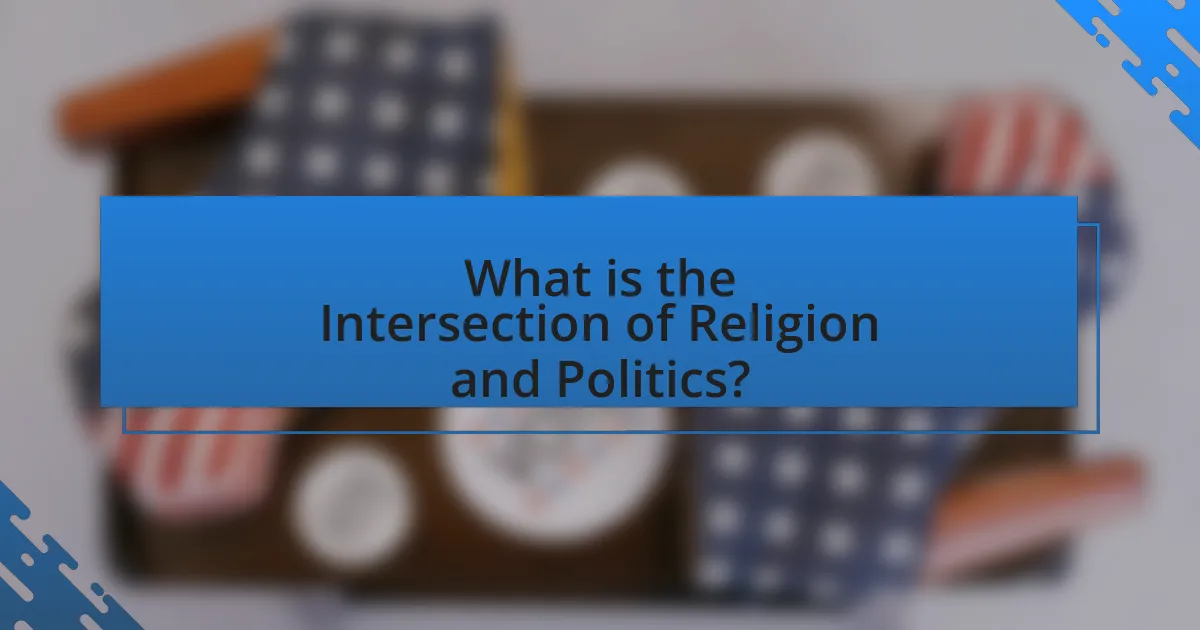
What is the Intersection of Religion and Politics?
The intersection of religion and politics refers to the ways in which religious beliefs and institutions influence political structures, policies, and behaviors. This relationship can manifest in various forms, such as the incorporation of religious values into laws, the mobilization of religious groups for political action, and the impact of political decisions on religious practices. Historical examples include the role of the Catholic Church in European politics during the Middle Ages and the influence of evangelical movements on American political parties in the 21st century. These instances illustrate how religion can shape political ideologies and governance, while political contexts can also affect religious freedoms and practices.
How do religion and politics influence each other?
Religion and politics influence each other through the shaping of societal values and governance structures. Religious beliefs often inform political ideologies, guiding the moral compass of laws and policies. For instance, in many countries, religious groups mobilize to advocate for specific legislation, such as laws on marriage or abortion, reflecting their doctrinal positions. Conversely, political entities may leverage religious sentiments to gain support, as seen in electoral campaigns where candidates align themselves with religious communities to secure votes. Historical examples include the role of the Catholic Church in influencing political decisions in Latin America during the 20th century, where liberation theology intertwined religious principles with social justice movements. This reciprocal relationship illustrates how religion can dictate political agendas while politics can shape religious practices and institutions.
What historical examples illustrate this influence?
The historical examples that illustrate the influence of religion on politics include the establishment of the Church of England in the 16th century, which was driven by King Henry VIII’s desire for an annulment that the Pope refused to grant. This led to significant political and religious changes in England, including the English Reformation. Another example is the role of the Catholic Church in the politics of medieval Europe, where popes wielded considerable power, influencing monarchs and shaping political alliances, as seen during the Investiture Controversy in the 11th century. Additionally, the intertwining of religion and politics is evident in the American Civil Rights Movement, where leaders like Martin Luther King Jr. utilized religious rhetoric to advocate for social justice and political change, demonstrating the power of faith in mobilizing political action.
How do different cultures perceive the relationship between religion and politics?
Different cultures perceive the relationship between religion and politics in varied ways, often influenced by historical, social, and ideological contexts. For instance, in the Middle East, many countries integrate Islamic principles into their legal systems, reflecting a perception that religion should guide political governance. In contrast, Western cultures, particularly in secular states like the United States, often advocate for a separation of church and state, viewing religion as a personal matter that should not influence political decisions. This divergence is supported by historical events, such as the establishment of the First Amendment in the U.S. Constitution, which emphasizes religious freedom and the separation of religious and governmental institutions. Additionally, in countries like India, the relationship is complex, as Hindu nationalism influences political discourse while also coexisting with a secular constitution. These examples illustrate how cultural contexts shape the understanding and implementation of the relationship between religion and politics.
Why is the study of this intersection important?
The study of the intersection of religion and politics is important because it reveals how belief systems influence governance and societal norms. Understanding this relationship helps to analyze the impact of religious ideologies on political decisions, policy-making, and social cohesion. For instance, research indicates that in countries where religion plays a significant role in politics, such as Iran and Saudi Arabia, laws and governance are heavily influenced by religious doctrines, affecting civil rights and freedoms. This intersection also shapes voter behavior and party alignment, as seen in the United States, where evangelical Christians significantly influence Republican policies. Thus, examining this intersection provides critical insights into the dynamics of power, identity, and conflict in various societies.
What implications does this relationship have for society?
The relationship between religion and politics significantly influences societal norms and governance structures. This intersection often shapes laws, public policies, and social values, leading to either cohesion or conflict within communities. For instance, in countries where religious beliefs heavily inform political decisions, such as Iran, theocratic governance can restrict individual freedoms and promote a specific moral framework, impacting citizens’ daily lives. Conversely, in secular states like the United States, the separation of church and state aims to protect diverse beliefs, fostering pluralism and tolerance. This dynamic illustrates how the interplay between religion and politics can either unify or divide societies, affecting everything from civil rights to social justice initiatives.
How does this intersection affect policy-making?
The intersection of religion and politics significantly affects policy-making by shaping the values and priorities of lawmakers and influencing public opinion. For instance, in countries where religious beliefs are deeply integrated into the political framework, such as Iran, policies often reflect religious doctrines, impacting areas like family law and education. Additionally, in the United States, the influence of religious groups on political campaigns and legislation, particularly on issues like abortion and same-sex marriage, demonstrates how religious perspectives can drive policy decisions. This relationship underscores the importance of understanding the role of religion in political contexts to grasp the complexities of policy-making processes.
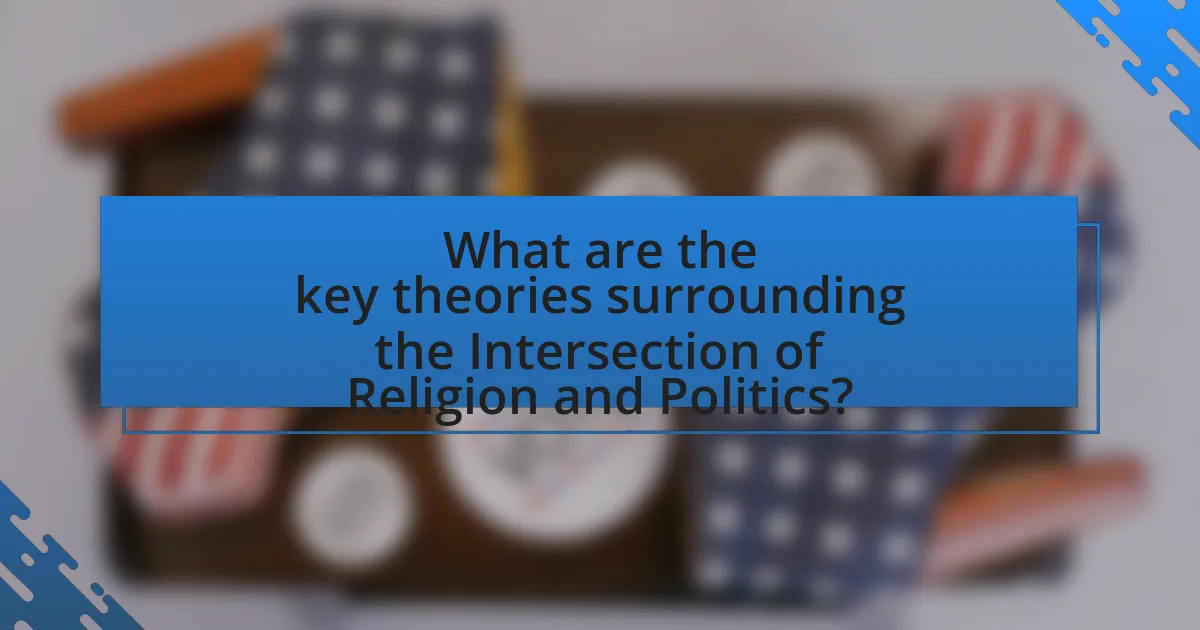
What are the key theories surrounding the Intersection of Religion and Politics?
The key theories surrounding the intersection of religion and politics include secularization theory, political theology, and the theory of civil religion. Secularization theory posits that as societies modernize, the influence of religion on political structures diminishes, a view supported by historical trends in Western democracies where religious authority has waned in governance. Political theology examines how religious beliefs shape political ideologies and practices, highlighting the role of religious narratives in legitimizing political power, as seen in various theocratic regimes. The theory of civil religion suggests that a shared set of beliefs and values, often derived from religious traditions, can unify a nation and influence its political culture, exemplified by the invocation of religious language in American political discourse. These theories provide a framework for understanding the complex dynamics between religious institutions and political authority across different contexts.
What are the major theoretical frameworks used in this analysis?
The major theoretical frameworks used in this analysis are secularization theory, political theology, and theocracy. Secularization theory posits that as societies modernize, the influence of religion on politics diminishes, which is supported by historical trends in Western democracies. Political theology examines the relationship between religious beliefs and political authority, emphasizing how religious narratives shape governance. Theocracy, on the other hand, explores systems where religious leaders control political power, as seen in various historical and contemporary states. These frameworks provide a comprehensive lens through which to analyze the complex interplay between religion and politics.
How does secularization theory explain the relationship?
Secularization theory explains the relationship between religion and politics by positing that as societies modernize, the influence of religion on public life diminishes. This theory suggests that increased rationalization, scientific understanding, and individualism lead to a decline in religious authority and participation in governance. For instance, in many Western democracies, the separation of church and state has become a foundational principle, resulting in policies that reflect secular values rather than religious doctrines. Empirical evidence supports this, as seen in the declining church attendance and the rise of secular political movements in countries like Sweden and the Netherlands, where religious institutions have less impact on legislative processes.
What role does political theology play in understanding this intersection?
Political theology plays a crucial role in understanding the intersection of religion and politics by providing a framework that examines how religious beliefs influence political structures and vice versa. This framework allows scholars to analyze the ways in which theological concepts shape political ideologies, governance, and public policy. For instance, the works of Carl Schmitt highlight the relationship between sovereignty and divine authority, illustrating how political decisions can be informed by theological principles. Additionally, the integration of religious narratives into political discourse can mobilize communities and legitimize authority, as seen in various historical contexts where religious leaders have played pivotal roles in political movements.
How do different political systems interact with religious institutions?
Different political systems interact with religious institutions in varied ways, primarily through the degree of separation or integration between state and religion. In secular political systems, such as those in France and the United States, there is a clear separation, which limits the influence of religious institutions on government policies and vice versa. This separation is often enshrined in law, as seen in the First Amendment of the U.S. Constitution, which prohibits the establishment of religion by Congress.
In contrast, theocratic systems, like Iran, integrate religious authority into governance, where religious leaders hold significant political power and influence legislation based on religious doctrine. This intertwining can lead to laws that reflect religious beliefs, impacting various aspects of life, including personal freedoms and social norms.
Hybrid systems, such as those in many Middle Eastern countries, exhibit a mix of secular and religious governance, where political leaders may use religious rhetoric to legitimize their authority while maintaining some secular laws. This interaction can create tension between progressive movements and traditional religious institutions, as seen in countries like Turkey, where secularism is constitutionally mandated but often challenged by political Islam.
Overall, the interaction between political systems and religious institutions is shaped by historical, cultural, and legal contexts, influencing the extent to which religion impacts governance and societal norms.
What are the characteristics of theocratic systems?
Theocratic systems are characterized by the integration of religious authority and political governance, where religious leaders or institutions hold significant power over state affairs. In these systems, laws and policies are often derived from religious texts or doctrines, leading to a governance structure that prioritizes religious principles over secular considerations. For instance, in Iran, the Supreme Leader, a religious figure, has ultimate authority, demonstrating how religious leadership can dominate political structures. Additionally, theocratic systems typically restrict political pluralism, as dissenting beliefs may be suppressed to maintain religious homogeneity, evident in countries like Saudi Arabia, where only one interpretation of Islam is officially recognized.
How do secular democracies manage religious influence?
Secular democracies manage religious influence by establishing a clear separation between religion and state, ensuring that governmental policies are not dictated by religious doctrines. This separation is often enshrined in constitutional frameworks, which promote religious freedom while preventing any single religion from dominating public policy. For instance, in the United States, the First Amendment guarantees the free exercise of religion while prohibiting the establishment of religion by the government. Additionally, secular democracies implement laws that protect individual rights and promote pluralism, allowing diverse religious beliefs to coexist without interference in political processes. This approach is supported by historical examples, such as the French laïcité, which emphasizes secularism in public life and restricts religious symbols in government institutions, thereby maintaining a neutral public sphere.
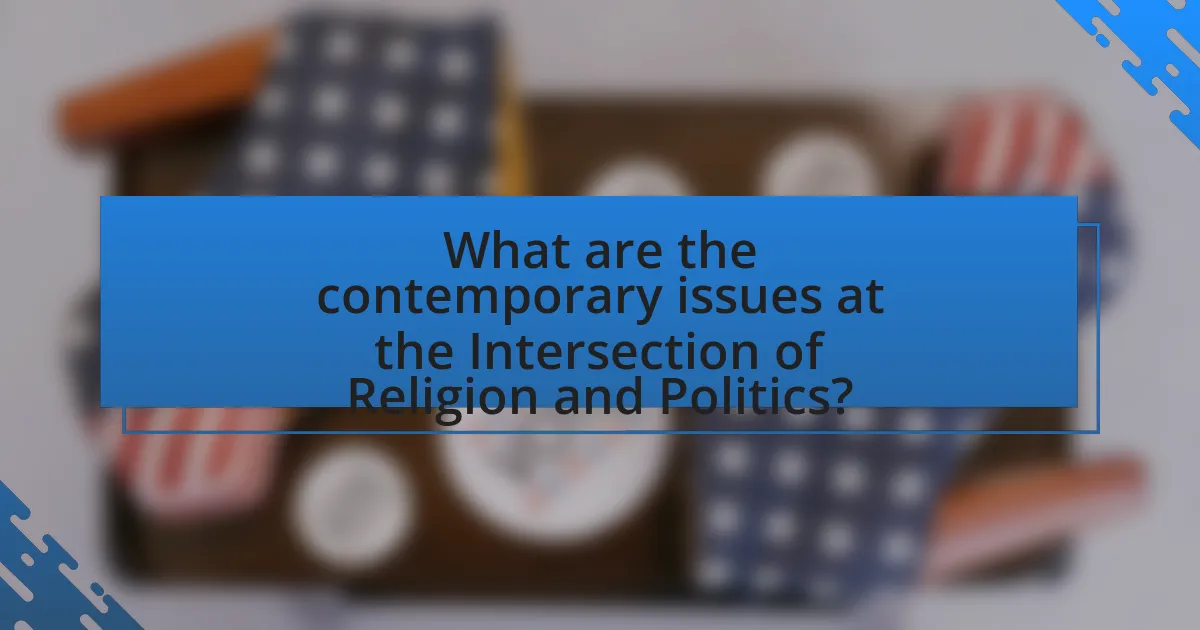
What are the contemporary issues at the Intersection of Religion and Politics?
Contemporary issues at the intersection of religion and politics include the rise of religious nationalism, the influence of religious groups on policy-making, and the ongoing debates over religious freedom versus secular governance. Religious nationalism has gained traction in various countries, leading to policies that prioritize specific religious identities over pluralism, as seen in India with the rise of Hindu nationalism. Additionally, religious organizations often lobby for legislation that aligns with their beliefs, impacting areas such as abortion rights and rights, exemplified by the influence of evangelical groups in the United States. Furthermore, the tension between maintaining religious freedom and enforcing secular laws is evident in debates surrounding the wearing of religious symbols in public spaces, as seen in France’s secularism laws. These issues highlight the complex dynamics between faith and governance in contemporary society.
How do current events reflect the intersection of religion and politics?
Current events illustrate the intersection of religion and politics through the influence of religious beliefs on policy-making and electoral outcomes. For example, in the United States, the rise of evangelical support for specific political candidates has significantly shaped policies on issues such as abortion and rights, reflecting how religious ideologies can drive political agendas. Additionally, in countries like India, the political landscape is heavily influenced by Hindu nationalism, which affects legislation and social dynamics, demonstrating the power of religion in shaping national identity and governance. These instances underscore the ongoing interplay between religious convictions and political actions, highlighting how current events serve as a barometer for this complex relationship.
What role does religion play in contemporary political movements?
Religion plays a significant role in contemporary political movements by influencing ideologies, mobilizing communities, and shaping policy agendas. For instance, religious groups often provide a moral framework that guides political activism, as seen in movements like the Christian Right in the United States, which has impacted legislation on issues such as abortion and same-sex marriage. Additionally, in regions like the Middle East, Islamic movements have been pivotal in political uprisings, exemplified by the Arab Spring, where religious identity was intertwined with demands for political reform. Studies indicate that approximately 80% of the world’s population identifies with a religious group, highlighting the substantial impact of religion on political landscapes globally.
How do global conflicts illustrate this intersection?
Global conflicts illustrate the intersection of religion and politics by demonstrating how religious ideologies can drive political agendas and influence state behavior. For instance, the Israeli-Palestinian conflict is deeply rooted in religious significance, with both sides claiming historical and spiritual ties to the land, which complicates political negotiations. Additionally, the rise of ISIS showcased how extremist interpretations of Islam were used to justify political violence and territorial ambitions, highlighting the role of religion in shaping political movements. These examples underscore that religious beliefs can significantly impact political dynamics, often leading to prolonged conflicts and influencing international relations.
What challenges arise from the intersection of religion and politics?
The intersection of religion and politics presents challenges such as the potential for conflict, discrimination, and the undermining of secular governance. Conflicts often arise when religious beliefs influence political decisions, leading to tensions between different religious groups or between religious and secular citizens. For instance, in countries like India, the intertwining of Hindu nationalism with political agendas has led to communal violence and social unrest. Discrimination can occur when laws favor one religion over others, as seen in various nations where religious minorities face legal and social disadvantages. Furthermore, the influence of religious ideologies on political policies can threaten the principle of secular governance, as evidenced by debates over issues like abortion and same-sex marriage in the United States, where religious beliefs significantly shape public policy.
How do religious extremism and political radicalism intersect?
Religious extremism and political radicalism intersect primarily through the use of religious ideologies to justify political actions and agendas. This intersection often manifests in movements where religious beliefs are leveraged to mobilize individuals towards political goals, as seen in various historical and contemporary contexts. For example, groups like ISIS have utilized a radical interpretation of Islam to legitimize their political objectives, leading to violent extremism and attempts to establish a theocratic state. Additionally, political radicalism can exploit religious sentiments to gain support, as evidenced by the rise of religiously affiliated political parties in countries like Iran, where the political system is heavily influenced by Islamic principles. This dynamic illustrates how religious narratives can serve as powerful tools for political mobilization and radicalization, creating a complex relationship between faith and governance.
What are the implications for human rights and freedoms?
The implications for human rights and freedoms in the context of the intersection of religion and politics are significant, as religious beliefs can influence governmental policies and societal norms. When political systems align closely with specific religious ideologies, it often leads to the marginalization of minority groups and restrictions on individual freedoms, such as freedom of expression and belief. For instance, in countries where Sharia law is implemented, there are documented cases of human rights violations, including gender discrimination and limitations on freedom of speech, as seen in nations like Saudi Arabia and Iran. These examples illustrate how the intertwining of religion and politics can create environments where human rights are compromised, thereby affecting the overall social fabric and individual liberties within those societies.
What best practices can be adopted to navigate the Intersection of Religion and Politics?
To navigate the intersection of religion and politics effectively, individuals and organizations should adopt practices that promote dialogue, respect, and inclusivity. Engaging in interfaith dialogue fosters understanding and reduces tensions between differing belief systems, as evidenced by initiatives like the Parliament of the World’s Religions, which has successfully brought together diverse religious groups to discuss common societal issues. Additionally, establishing clear boundaries between religious beliefs and political actions can help maintain a secular governance framework, as seen in countries like France, where laïcité ensures that religion does not interfere with state affairs. Furthermore, promoting civic education that includes discussions on the role of religion in public life can empower citizens to make informed decisions, as demonstrated by programs in various democracies that encourage critical thinking about the influence of faith on policy. These best practices collectively contribute to a more harmonious coexistence of religious and political spheres.

